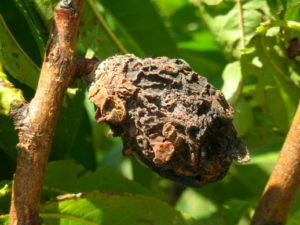It isn’t every year we get our peach trees to produce, but when we do, we want to make sure we get them to harvest! One of the most important sprays to protect peaches from leaf curl (Fig. 1) should have gone in late fall (best time) or in late winter (by end of February), if all else fails. Infection by the leaf curl fungus occurs as the bud swells while under wet weather conditions (which would be most springs); late spring applications are simply not as effective. Several fungicides are effective when applied in the fall or late winter, including Bravo weather Stik and Ziram; although coppers are labeled and effective, I worry about phytotoxicity and recommend avoiding coppers with stone fruit whenever possible. Hopefully, this was taken care of and is a non-issue and none of you are seeing curl.

Leaf curl causes blistering and distortion on peach leaves in the spring. A single fall applications of fungicide is all it takes to prevent this
The biggest worry for our peaches (and other stone fruit) is brown rot, and fortunately, you have time to be proactive and prevent infection! Brown rot control needs to begin at pink and peach scab control needs to be added to that around petal fall. Both fungal diseases need to be managed throughout the season until harvest. A lot of growers had significant problems with brown rot last year. Mummy (Fig.2) removal, pruning out cankers, good orchard sanitation, and timely application of fungicide, especially after rains exceeding 2” are essential for control of both diseases. Both brown rot and peach scab are capable of producing spores now; keeping trees protected with fungicide during wetting periods is essential to bringing the crop to harvest. The worst thing about these two pathogens is that the symptoms and signs of these disease seem to appear suddenly around harvest; in reality, the infection process often began two months ago (meaning as you are reading this now!). See the 2017 Midwest Fruit Pest Management Guide (https://ag.purdue.edu/hla/Hort/Pages/sfg_sprayguide.aspx ) for more information regarding peach disease management.

Mummies from previous brown rot infections serve as a source of inoculum to cause infections this year